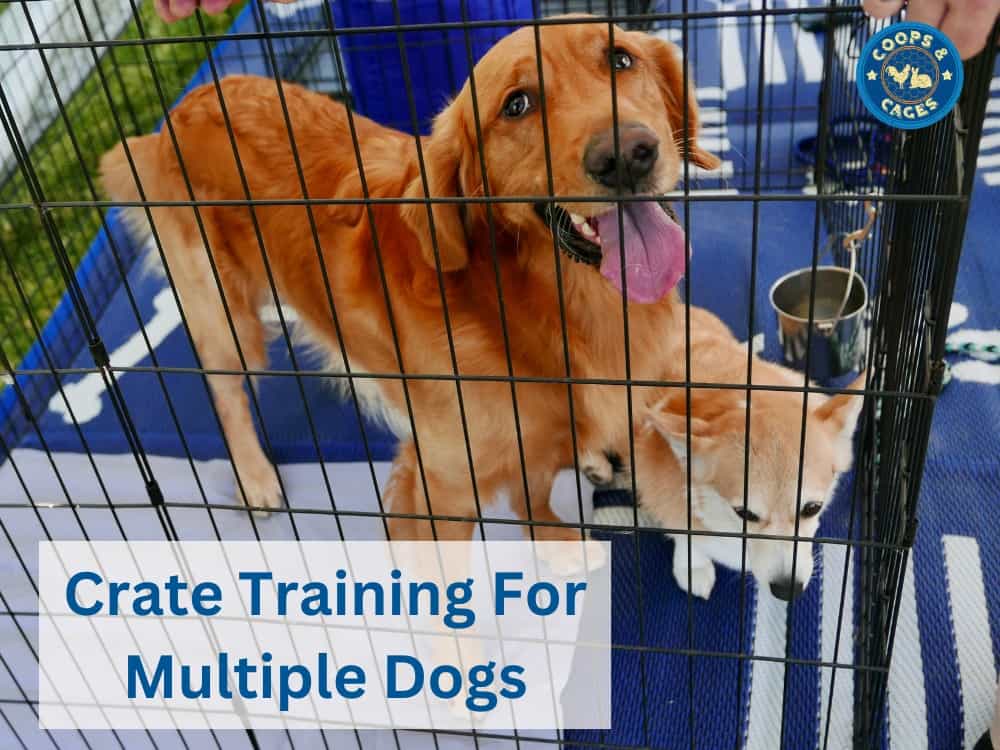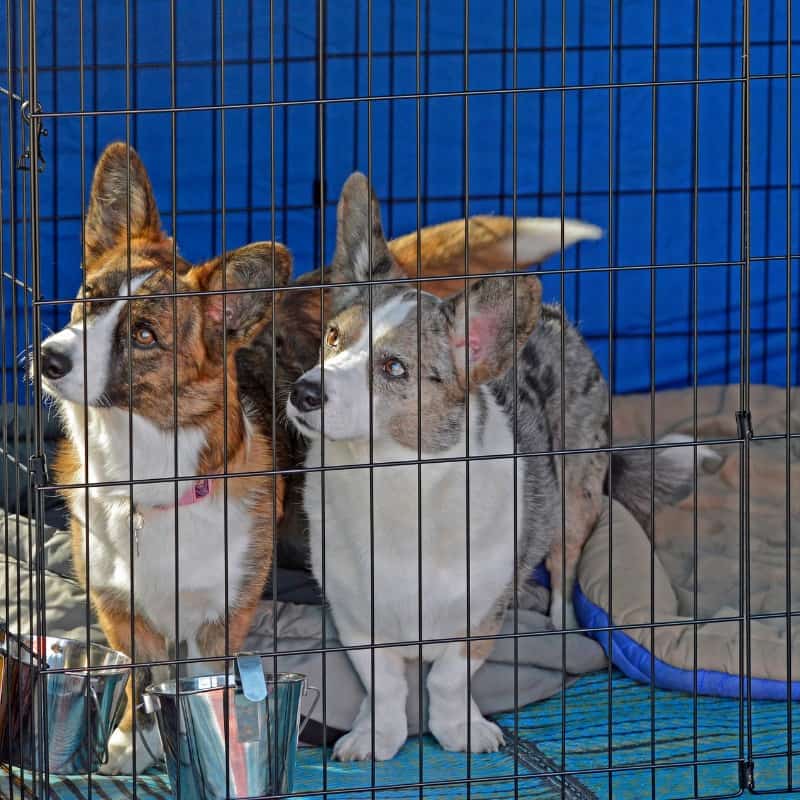Crate training for multiple dogs is a great way to provide your pets with their own personal space. This blog post will delve into the intricacies of crate training for multiple dogs simultaneously while ensuring their safety and well-being.
We’ll discuss how to crate train multiple dogs, the benefits of crate training and how to choose the right size crate.
We’ll also cover how to address common challenges, resource guarding issues and offer solutions to create harmony within their shared living space.
Lastly, we’ll introduce you to high-quality dog crates from Coops and Cages that cater specifically to pet owners who value durability, security, and style in their pet enclosures.
Is it Okay to Put Two Dogs in One Crate?
We recommend that each dog has its own crate. This allows each dog a safe space to retreat with enough room to get comfortable.
If you have two adult dogs inside one crate, it is likely to cause conflict. If one dog suddenly becomes aggressive when you are not there, the other dog has nowhere to escape. This can lead to fighting, injury and long-term tension between the two dogs.
Young puppies from the same litter are an exception to this rule. They will usually lay together happily and keep each other warm.
In rare cases, bonded adult dogs can be crate trained together. However, we do not recommend it unless you are an experienced dog trainer and know the animals extremely well.
How to Crate Train Multiple Dogs
When crate training multiple dogs, the most important thing is patience! It can be a long process but worthwhile if done properly.
Follow these tips for successful multi-dog crate training:
- Start Early: If possible, crate train your dogs from a young age. Older dogs can be harder to train.
- Make the Crate Comfy: You want your dogs to view their crates as warm, inviting areas. Crates make a cosy den if you fill them with soft bedding and blankets.
- Introduce the Crate Slowly: Bring each dog over to their crate while the crate door is open. When a dog approaches or enters their crate on their own, praise them.
- Feed Your Dogs Inside Their Crates: If your dog enters the crate willingly, give it a treat. Feed them their meals for a few days inside their crate. If your dog is hesitant, you could place the food nearby the crate and move the bowl a little further closer each meal.
- Try Closing the Door: Once your dog seems comfortable sitting inside its own crate, slowly close the door and stay nearby. Praise your dog when it responds positively to a closed crate. If your dog whines or cries, it may not be ready for a closed door yet and may need to try progressing at a slower rate.
- Increase Time In the Crate: Leave your dog in its closed crate for short periods at first and then gradually increase the amount of time. Try leaving the room for short periods too. It is important to be very patient and not rush this process.
- Establish Routines: Practice training a little bit every day. Establish routines for feeding and toilet breaks as most dogs thrive on consistency.
Read more tips here.
Benefits of Crate Training for Multiple Dogs
Dogs are naturally den animals, meaning they feel safe in an enclosed space. A properly trained dog will view its crate as a safe space that it can retreat to for rest. It will not view it as a cage or feel trapped.
There are multiple benefits to teaching your dog to love its crate:
- Reduces Anxiety: A crate is a safe space your dog can go to feel protected during stressful situations, such as storms or fireworks.
- Helps Potty Training: Dogs instinctively don’t want to go to the toilet where they eat or sleep. Therefore, being inside a crate will encourage them to have fewer accidents and help with potty training. Always allow your dog regular toilet breaks from its crate, even during house training. Note that young puppies may need to wee every 1-2 hours.
- Travel: A dog crate is a safe way to transport your dog in the car.
- Restricting Movement: You can safely lock your dog away in its crate if you need it kept away from a stressful event, such as young children visiting your house or paramedics arriving during a medical emergency.
- Comfort When Crating is Required: There may be places your dog has to be crated or enclosed in a small room, such as the vet or a boarding kennel. Crate training your dog will help these situations be more pleasant for your pup.
- Vet Recommendations: If your dog ever has to undergo serious surgery, particularly on its legs, the vet may recommend the dog be confined to a crate while it heals. If your dog is already crate trained, this will make the process much less stressful and aid in faster healing.
Choosing the Right Size Crate
It is very important you choose the right size crate for your furry friend. If your dog feels cramped inside its crate, it is less likely to feel comfortable and enjoy the experience.
But if your dog has too much space in its crate, it is more likely to go to the toilet inside the crate.
Follow these tips for choosing the right size crate:
- Measure Your Dog: Get out a tape measure and measure your dog from nose to tail tip and from feet to the top of the head. Allow an extra 5-10cm on each side so the dog can stand up, turn around and get comfortable without hitting into the side walls.
- Extra Room: Consider what else you plan to put inside the crate and allow extra room for this, such as bedding, bowls or toys.
- Breed Guidelines: Check what size crate the store recommends for your breed. However, only use this as a guideline! Don’t rely solely on breed recommendations as every dog is unique in size and build. It is more important to check the dimensions.
- Location: Think about where the crate is going in your house and whether it will fit. If your crate is for car transport only, check that it will fit through the car boot opening.
- Multiple Dogs: If you have decided to put multiple dogs in one crate, you will need to allow double the room so each dog can get comfortable without hitting into the other one.
At Coops and Cages, we offer five sizes of dog crates to suit all breeds. They include:
- Small 24″: Recommended for chihuahuas, Pomeranians, toy poodles and pugs. Also suitable for puppies and cats.
- Medium 30″: Recommended for French bulldogs, jack Russell terriers, Maltese terriers and shih tzus.
- Large 36″: Recommended for beagles, dachshunds, miniature poodles and cavalier King Charles spaniels.
- Extra Large 42″: Recommended for border collies, golden retrievers, labradors and standard poodles.
- Extra Extra Large 48″: Recommended for German shepherds, greyhounds, boxers and bull Arabs.
Managing Feeding and Resource Guarding
When you crate train multiple dogs, there is a risk the dogs will become overly protective of their resources. This is most commonly seen with dogs protecting their food but it could also be water, toys, bedding or anything your dog “owns”.
This is a natural response as one dog may fear the other dog will take away their food. If your dog whines, growls at or bites the other dog, these could be symptoms of resource guarding.
In the wild, this instinct would help dogs survive and not starve. But in your home, it is unnecessary and can lead to injuries.
Use these tips to help overcome resource guarding:
- Create a Feeding Schedule: Feed your dogs together at the same time every day. A consistent feeding routine will help your dog feel secure that food is coming, resources are not limited, and there is no need to fight.
- Maintain Distance: Place the dog crates far enough apart to prevent disputes or distractions during feeding time.
- Reward Good Behaviour: If your dog does not react to the other dog being near its food or other treasured item, praise both dogs with a high-pitched tone.
- Teach your dog “Leave It”: Teaching both dogs to “leave it” on command gives you a safe way to get the aggressive dog to leave an item alone if it is causing issues.
By following these tips and ensuring fairness among all pets involved, you’ll create a harmonious living space that benefits both you and your furry companions.
Challenges Crate Training for Multiple Dogs
Training two dogs at once can be double as challenging. They can distract each other or get jealous of any attention you give the other dog.
If you are having trouble juggling two, try these tips:
- Crate Spacing: Try training with both crates close together. If your dogs don’t handle this well, try training with the crates further apart. It will depend on how the dogs are bonded to which works better for them.
- Share Praise: Be careful not to favour one dog over the other. This can lead to jealousy! Teach them that if one dog does good, everyone wins.
- Schedule Individual Attention: Outside of training time, make sure to give each dog some one-on-one positive attention from you every day. Make sure each pup feels loved!
- Train One Dog at a Time: It may be best to do crate training sessions with each dog individually at first. Once each dog individually is getting the hang of it, then bring the two dogs into the same room together for crate time.
- Seek Professional Help: If conflicts persist, consult a professional dog trainer or behaviourist for guidance.
For some owners, training two dogs together can actually be a benefit. If one dog gets the hang of crate training quite quickly, it may teach the other dog and help it to learn faster.
High-Quality Dog Crates with Coops and Cages
For a safe and comfortable crate training experience for your pups, check out our high-quality dog crates. Coops and Cages crates have many benefits over other brands:
- The Perfect Fit: Our crates are available in 5 sizes, to suit all breeds of dog. Our smallest crate can also be used for transporting cats.
- Built to Last: Our dog crates are made from sturdy metal wire construction, ensuring durability and longevity.
- Collapsible: The crates can easily collapse for storage when not in use.
- No Assembly: No complicated assembly. The crate comes already collapsed flat in its carton – simply pop it up into shape when ready to use.
- Removable Plastic Tray: The plastic tray easily slides out to clean.
- Easy Access: All our crates have two doors for easy access – one crate door on the longer side, and another on the shorter end.
Coops and Cages’ dog crates are the perfect choice for your multiple-dog crate training journey.
FAQs in Relation to Crate Training for Multiple Dogs
How to Crate Train Multiple Dogs at Once?
Introduce each dog to their own crate, establish a routine, increase the time gradually, and reward positive behaviour.
Is it Okay to Crate Train One Dog and Not the Other?
Yes, it’s acceptable to only crate train one dog if they have different needs or behaviours. However, most owners find it beneficial to crate train all of their dogs.
Is Crate Training Right for Every Dog?
No, factors such as age, temperament, anxiety levels, and medical conditions should be considered. Consult with a professional trainer or veterinarian.
Conclusion
Crate training is beneficial for both dogs and their owners. Crates help to make a secure living space for dogs who are naturally den animals. Crate training also helps to make house training and transport easier, plus vet visits and time in a boarding kennel.
When crate training for multiple dogs, it is best to have one dog per crate. Always choose a crate that is the appropriate size.
During training, it is important to always be patient, introduce the crate slowly, overcome challenges promptly, and avoid resource guarding issues.
If you’re looking for a quality crate, Coops and Cages offer five durable and comfortable options for your furry friends. Check them out here.





